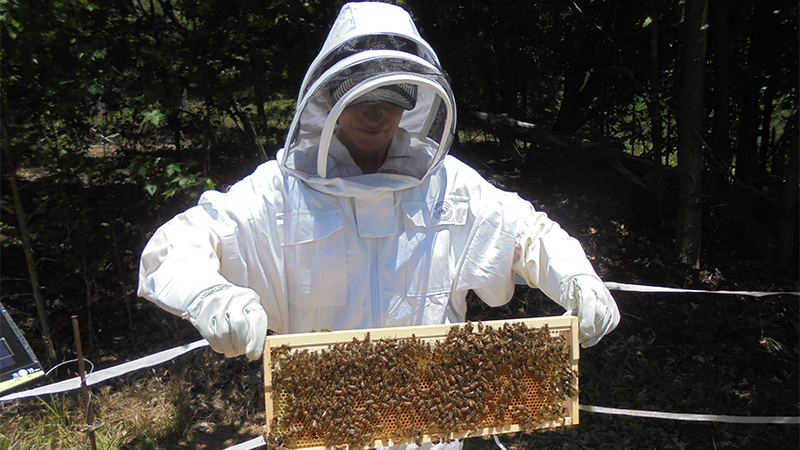Show me the honey
Published 4:01 pm Thursday, July 6, 2017

- Polk County beekeeper Lisa Krolak inspects a hive.
Written by Mark Schmerling
Photos by Mark Schmerling and submitted by David Smith
Raw honey contains up to 80 substances including glucose, fructose, the whole B-vitamin complex, vitamins A, C, D, E and K, plus minerals and the trace elements of magnesium, phosphorus, iron, calcium, sodium and copper, plus sulfur, chlorine, iodine and manganese, all important to human nutrition.
Trending
In addition, bees, including honeybees, pollinate many foods we enjoy. And Polk County residents who support local beekeepers also love the flavor of honey, and its usefulness in many recipes.
Those local beekeepers and bee enthusiasts now have a forum at the Mill Spring Agricultural Center, to gather and share lessons, tips and advice, drawing from the experience of long-time pros in the fields and orchards. The beekeepers association normally meets the third Thursday of the month at 6 p.m. Format is open discussion and attendees are invited to bring their experiences and questions.
PESTICIDES AND HERBICIDES
Always a concern, if not an immediate threat, is the use of pesticides and herbicides on crops and orchards in surrounding areas. While herbicide and pesticide use has been blamed for bee die-offs in some areas and can be a factor in this region, local officials note that such use in Polk County is rather limited. However, the increased use of chemicals can produce indirect effects on bees.
Saluda-area honey fanciers probably know of beekeeper Phil Holbert, who not only sells his locally produced honey, but who also sells beekeeping supplies, at Holbert’s Bee Supply on Ozone Drive, Saluda. He has kept bees for 35 years.
Holbert mentioned recent herbicide use by the power company in the Sunny View area of Polk County.
Trending
Has Holbert encountered problems with chemicals? “Not too much here lately. Some others might have a different opinion.”
David Smith of Polk’s Beekeepers Association, and another local beekeeper, Lisa Krolak, acknowledge that while herbicides and pesticides are not used on a large scale in Polk County, they can kill bees.
Smith noted that some apple growers in Henderson County use chemicals, which can harm bees. However, bees’ flight patterns might save many from harm, he added.
In spite of the bees’ best efforts and evolutionary benefits, beekeepers in other areas have reported serious die-offs.
Last August in Dorchester County, S.C., millions of honeybees (2.5 million in one location) died from spraying aimed to kill mosquitoes carrying the Zika Virus. In this case, the chemical killer was Naled, which kills mosquitoes on contact, and has been used in the U.S. since 1959. EPA officials emphasize that Naled dissipates so quickly that is allegedly not a hazard to humans.
In this case, spraying was conducted after dawn, when bees are active, rather than at night, when bees are not out.
At least one official in South Carolina emphasized that agencies in charge of spraying must have better relationships with the beekeeping community. Officials in South Carolina assert that wild and captive bee populations can recover from such incidents, but also acknowledge that beekeepers suffer financially when such losses occur.
The Fieldmatch program in Polk County is aimed at preventing such episodes, according to Smith. A national program, Fieldmatch helps coordinate beekeepers and chemical sprayers. To be part of this, beekeepers must register their hives.
THREATS TO THE HIVE
Krolak observed that in Polk County, the issue isn’t so much with pesticides as the prevalence of mites, which can take down bees’ immune systems. When that happens, a species of moth can take over the hives and eat the honey.
Leading the discussion at the June meeting of the Polk Beekeepers Association, Holbert told those gathered that mites favor high drone populations, and that mites can live as long as eight months. According to Holbert, one way to rid the hive of mites is the use of oxalic acid.
Holbert added that mites will not harm the honeycomb, and that freezing the comb over winter will kill mites.
Holbert also described the method known as “sugar shake” to help reduce mite populations in the hive. Covering affected bees with powdered sugar and properly rolling that mass of mite and sugar-covered bees are steps in removing the mites.
Though researchers aren’t sure what has caused the increased mite populations, he feels it might be related to the increased use of chemicals in agricultural production generally.
“(Mite) Treatment now can mean the difference between having bees and not having bees,” Holbert advised.
Another problem facing Polk’s beekeepers is hive beetles. To a certain degree, the bees can herd these beetles. But beekeepers can also trap them with sticky substances in the hive.
WEATHER CONCERNS
Of course, like with any crop, the weather is always a top of mind factor with bee production and yield.
Holbert mentioned that honey production was low earlier this year, limited by wind and rain.
Regarding weather, Smith observed that this spring it got warm, and stayed warm, and the bees ate their stored honey. “It hit their cycle a little bit, and decreased honey production,” he noted.
Holbert recommends feeding bees from about mid-August through mid-September, when the bees lay, he said. These are the eggs that will carry the bees over the winter. Holbert said that feeding simulates nectar.
“Whatever you do in that month will affect how bees survive the winter.”
BEE ZONES
Beekeepers need to strike a fine balance with their populations. If hives become over-populated, bees will swarm, and leave the hive. All one can do is hope they swarm on the property, and then the beekeeper can try to get them back in the hive.
Smith noted that bees seldom fly more than 2.5 miles from their hive in search of nectar. He said that if you look at Google Earth, draw a two-mile circle, “you’re going to be amazed at how much ground that covers. Polk County bees whose normal flight takes them to sprayed apple orchards in Henderson County could be harmed, but most Polk County bees probably don’t fly far enough to encounter such danger.”
“The bees are incredible creatures,” Smith noted, observing that that bees will travel to the best flowers, “to get the biggest bang for the buck,” an adaptation that has occurred “over the millennia of evolution.”
Bees communicate with each other to indicate travel to various food sources.
Smith noted that bees have two stomachs. One is for the normal processing of the animal’s digestive needs. The other stores nectar, to which bees add an enzyme that transforms the nectar into a different sugar.
“They’ve got a good system worked out,” Smith observed.





